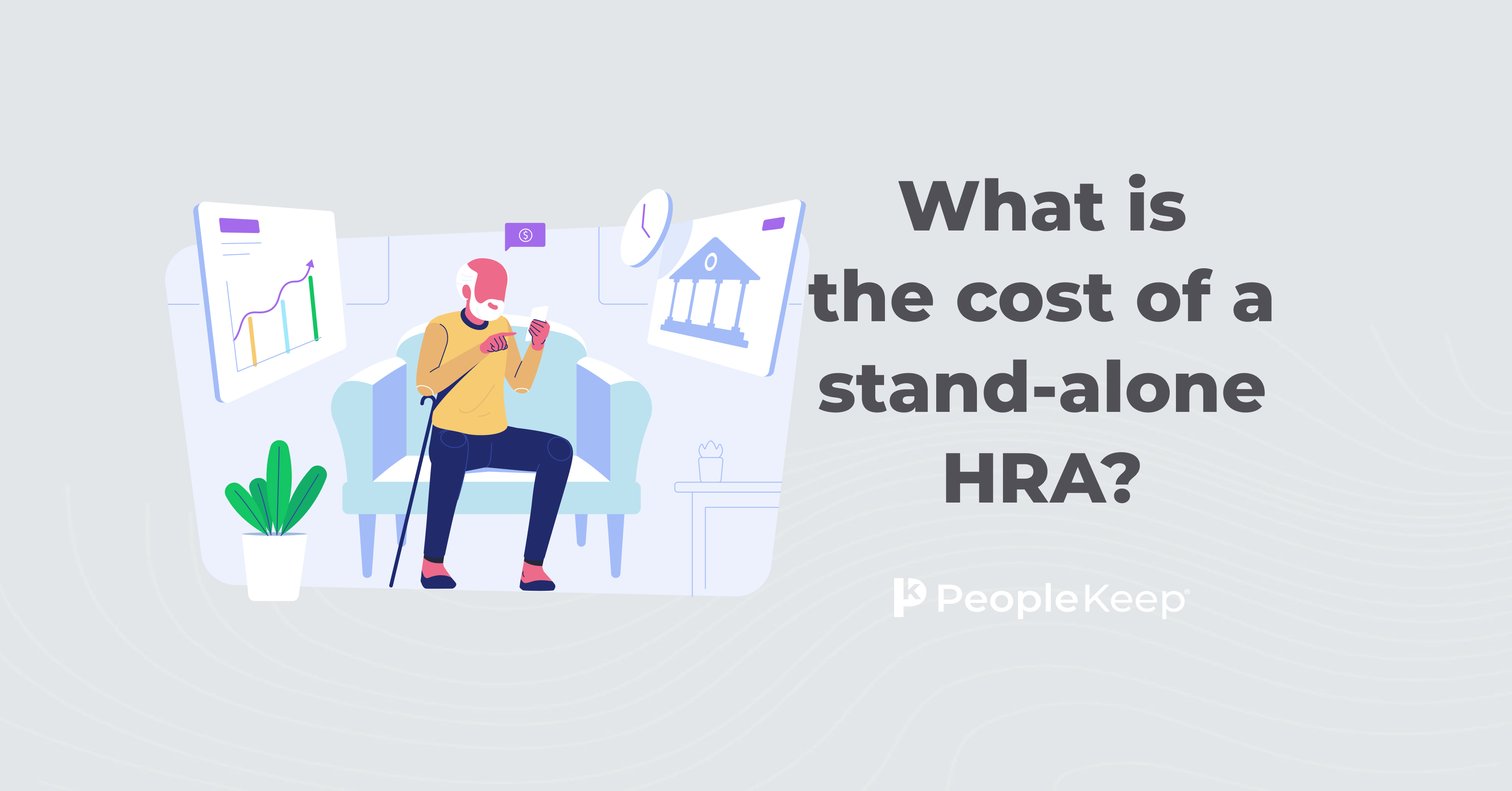How the QSEHRA works for employees without minimum essential coverage
By Elizabeth Walker on April 29, 2024 at 9:11 AM
When Congress passed the 21st Century Cures Act, it created an alternative health benefit option to traditional group health plans—the qualified small employer health reimbursement arrangement (QSEHRA) or small business HRA1.
With a budget-friendly QSEHRA, eligible employers can reimburse individual employees tax-free for qualifying medical costs and individual insurance premiums, so long as they have coverage that meets minimum essential coverage (MEC). But can uninsured employees or those with a plan that doesn’t meet MEC still benefit from a QSEHRA?
Below, we’ll go over QSEHRA participation and MEC requirements for employers, how it works for employees without MEC, and how to administer the plan compliantly for your employees regardless of their health coverage status.
Takeaways from this blog post:
- QSEHRA allows small businesses with up to 49 full-time employees to reimburse staff for individual health insurance premiums and out-of-pocket medical expenses.
- The Internal Revenue Service (IRS) doesn’t allow employees without minimum essential coverage (MEC) to participate in a QSEHRA. But, if they enroll in a qualifying health insurance plan with MEC, their employer can reimburse them tax-free for qualified medical expenses. If an employer mistakenly reimburses expenses for an employee without MEC, they must be included as taxable income on the employee's W-2.
- Employers must provide annual notices to employees about their QSEHRA benefits, including information about potential tax penalties for not maintaining MEC.
How does a QSEHRA work?
Before diving into the rules and regulations of a QSEHRA, let’s first cover the basics of how it works and its benefits.
Under a QSEHRA, organizations with 1–49 full-time equivalent employees (FTEs) can reimburse their staff for individual health insurance premiums and qualified out-of-pocket medical expenses. Unlike traditional employer-sponsored coverage—which forces employees into a health plan their employer chooses—a QSEHRA allows employees to choose the best medical coverage for them via a public or private health exchange and receive reimbursements from their employer for the selected plan’s premium.
QSEHRAs don’t rely on employee contributions. Instead, they’re funded entirely through pre-tax employer contributions and only up to an annual maximum limit amount. The IRS updates annual limits for both individuals and families. There are no minimum limits with a QSEHRA. For 2025, small businesses can offer up to $6,350 a year for self-only employees and $12,800 for employees with a family.
Through the QSEHRA, a small employer establishes a set monthly allowance up to the maximum limit for individual employees, reducing the risk of costly budget surprises. Once an employee incurs a qualified medical expense and their proof of payment is verified and approved, the employer reimburses them up to their maximum allowance amount. Once an employee hits their allowance limit, they can’t exceed it.
QSEHRA funds roll over monthly. Unlike health savings accounts (HSAs) or flexible spending accounts (FSA), any unused employer contributions in the QSEHRA at the end of the plan year stay with the employer.
A QSEHRA is tax-deductible for small employers and is often a more affordable healthcare coverage option than traditional employer-sponsored insurance. Employees also have access to a health benefit free of income taxes —provided they have a health insurance plan that meets MEC requirements.
Examples of plans that meet MEC are most major medical plans purchased on the individual market, coverage through a spouse’s or parent’s traditional group health insurance, or coverage through a government-sponsored program like Medicare or Medicaid (except those that provide limited coverage). Offering a QSEHRA allows employees without coverage to purchase an individual health insurance plan that works best for their needs.
The QSEHRA makes providing health benefits accessible for thousands of small businesses that couldn’t offer one without this type of plan. Our 2024 QSEHRA Report shows that 76.8% of employers offering a QSEHRA through PeopleKeep didn’t offer a health benefit before implementing a QSEHRA.
This highlights how empowering a QSEHRA can be for small employers who thought affordable health insurance coverage wasn’t available.
What are the QSEHRA employee eligibility requirements?
The 21st Century Cures Act outlines QSEHRA participation requirements for individuals2. Generally speaking, eligibility criteria for the benefit are pretty broad; a person simply needs to work for—or be the spouse or dependent of someone who works for—a qualified small business offering a QSEHRA.
However, a small business owner can exclude the following classes of employees:
- Part-time employees
- Seasonal employees
- Employees who have not completed 90 days of service
- Employees younger than 25
- Union employees (unless the relevant collective bargaining agreement provides for eligibility)
- Nonresident aliens with no U.S. sources of household income
Beyond that, employees are eligible to receive reimbursements through a QSEHRA after they provide “proof of coverage” for the payment of qualified medical services and other expenses.
In this context, “proof of coverage” means proof that the eligible employee incurred a cost covered by the QSEHRA. Acceptable forms of proof for qualified expenses could be medical bills, receipts, or invoices.
Any employee with MEC who meets the requirements listed above and submits proof of an eligible health expense can get eligible products and services reimbursed through the QSEHRA.
However, those without MEC who try and participate in the QSEHRA will run into challenges. This leads us to the next section on tax qualification.
Who qualifies for tax benefits?
One of the biggest advantages of a QSEHRA is its tax-free status for small employers and employees. Organizations administering a QSEHRA won’t be subject to payroll taxes for the reimbursements they issue employees. Additionally, in many cases, employees won’t have to pay federal income taxes or payroll taxes on their reimbursements.
Small businesses will receive tax advantages regardless of their employees' health insurance policy status. Employees, however, must have MEC to participate in the QSEHRA and receive tax-free reimbursement.
If you have questions regarding the tax implications of the QSEHRA, work with a tax professional to ensure you’ve done everything correctly.
What about my employees without minimum essential coverage?
The IRS provided guidance on this in Question 62 of Internal Revenue Bulletin 2017-67. Employees without MEC—including uninsured individuals and those with a Medi-Share or healthcare sharing ministry plan—can’t receive tax-free QSEHRA reimbursements for medical expenses3.
But, suppose you reimbursed an employee for an eligible expense during a month the employee didn’t have MEC. In that case, you must report the reimbursement amount on the employee’s Form W-2 as taxable income. You’ll do this in box 1 as other compensation.
If an employee eventually enrolls in health insurance coverage that meets MEC requirements, they can begin receiving QSEHRA reimbursements.
Do I need to do anything differently when administering the QSEHRA for employees without MEC?
The only difference between QSEHRA administration requirements for your staff members without MEC and those with MEC are the employee notice requirements. It’s your responsibility to provide comprehensive guidance and education to your employees without MEC, such as qualifying individual health coverage or a spouse’s group plan, about the potential tax consequences.
The federal government requires small business employers to notify employees of the QSEHRA benefit yearly. In addition to informing employees of their benefit amount, you must explain how QSEHRAs work with premium tax credits. With a QSEHRA, only employees with an unaffordable allowance can collect tax credits. Employees who qualify for a premium subsidy and have an unaffordable allowance must reduce their tax credit by their allowance amount.
The QSEHRA notice must also explain that employees could be subject to a tax penalty if they fail to maintain MEC during the year. Lastly, the notice must explain that the IRS prohibits employees without MEC from receiving any reimbursements. Any reimbursements they may receive when they don’t have MEC will be included in their taxable gross income, according to QSEHRA W-2 requirements.
Once you’ve sent the notice, you’ve done all you need to do. The only time a small business owner must legally track employees’ tax liability for QSEHRA benefits is for their first reimbursement request during the plan year. At that time, employees must provide proof of MEC, such as an insurance card, or attest that they have MEC coverage and provide the company name and coverage date for the policy.
IRS Notice 2017-67 states that eligible employers “may rely on the employee’s attestation unless the employer has actual knowledge that the individual whose expense is submitted does not have MEC.”
Conclusion
Unlike traditional employer-sponsored plans, the QSEHRA is a flexible and affordable small business health benefit that can support every employee’s needs. Rather than simply increasing their employees’ wages, employers can leverage a QSEHRA as a healthcare benefit and enjoy the peace of mind that comes with knowing their employees can only use their funds on healthcare.
Employees without MEC can’t receive reimbursements. Therefore, to ensure they can participate in their QSEHRA benefit, encourage them to enroll in a qualified health plan to take advantage of their allowance amount and start receiving tax-free reimbursements on their healthcare expenses.
This article is for informational purposes only. You shouldn’t take it as tax or legal advice. If you have questions about the taxability of your QSEHRA, consult with a tax professional.
This article was originally published on May 22, 2017. It was last updated on April 29, 2024.
Check out more resources
See these related articles

What is a zero cost sharing plan?
In this blog, we go over what zero cost sharing plans are and what other health benefit options exist for those who don’t qualify.

QSEHRA rules you need to know
Stay compliant with QSEHRA rules by familiarizing yourself with the requirements in this beginner-friendly guide. Start simplifying your healthcare benefits.

What is the cost of a stand-alone HRA?
Looking to budget for a stand-alone HRA? Get all the information you need on pricing and expenses in this comprehensive guide.


